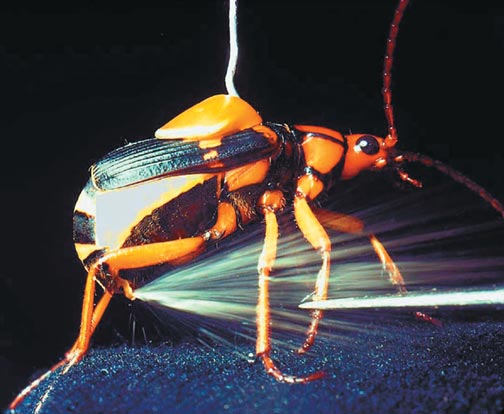Insect Inspiration
By Greg Ross
A sharpshooting beetle may trigger new ideas for aircraft engineers
A sharpshooting beetle may trigger new ideas for aircraft engineers

DOI: 10.1511/2004.46.0
Andy McIntosh has enlisted an unusual partner for his engineering research—one with six legs.
A professor of thermodynamics and combustion theory at the University of Leeds in England, McIntosh is seeking a more reliable way to reignite aircraft gas turbine engines, which sometimes go out in flight. When this happens, an electrode fires, producing a small explosion that sends a stream of charged particles into the engine. Unfortunately, these particles don’t always travel far enough to kindle a reaction.
It's here that McIntosh has found a biological inspiration. Common throughout the world, the bombardier beetle (Brachinus) has a uniquely adapted defense against predators. By producing a set of repeated chemical explosions in a combustion chamber in its abdomen, the insect creates a biological Gatling gun that can fire a pulsed jet of boiling fluid in almost any direction. "It will scald you if you put your hand nearby," McIntosh says. "Frogs, spiders, ants and birds which try to eat this creature get stopped by this ejection, so they learn not to touch it."

Thomas Eisner and Daniel Aneshansley / Cornell
The natural designs involved are so efficient that McIntosh wants to adapt them to improve engine reigniters. Specifically, he's found that the shape of the beetle's combustion chamber and its nozzle are very important in maximizing the amount of material ejected by each explosion. And "that could be the great advantage for reigniters of gas turbines," he says. More efficient ejection could send ionized particles farther into an extinguished engine, increasing the chance of restarting it successfully.
McIntosh's studies build on the work of Thomas Eisner, a Cornell biologist whose interest in the beetle dates to his days as a graduate student at Harvard, when he first collected some of the insects in a meadow in Lexington, Massachusetts. "I picked them up and they made popping sounds and shot out this stuff, and I got interested from that moment on," he says. "So I started off by working on the aiming of the beetle and experiments with predators."
Recordings made by Eisner and his collaborators showed that the sound of the beetle’s blasts was pulsed, and inducing the insect to fire on a piezoelectric crystal yielded an alternating current. "So we got this indirect proof that the animal is shooting out [ejecta] like water out of a Waterpik, but at 500–1,000 pulses per second."
For the final proof, Eisner, himself a photographer, seized the chance to work with Harold Edgerton, an engineer at the Massachusetts Institute of Technology who was a pioneer in high-speed photography.
Eisner displayed a beetle for Edgerton's freshman seminar, and the two filmed the insect that afternoon with Edgerton’s fast-action camera and pulsed electronic lights. Within an hour they were looking at wet film, developed in-house at MIT. "It was one of the most exciting moments of my life," Eisner says. "Because we'd predicted it—wonderful footage where the stuff comes out at 2,600 frames per second."
It was Edgerton's footage that gave McIntosh his first look at the insect in action, in a documentary that Eisner made with the BBC. "I thought wow, this is extraordinary," McIntosh says. "That footage has been inspirational to me to see that, well, maybe we can learn from the combustion in this creature."
In adapting the beetle's technique to engine reigniters, McIntosh will first seek to understand the steam explosion involved in the beetle's defense. Then he plans to model the heart-shaped combustion chamber using a methane-air explosion, to understand whether the shapes of the chamber and nozzle are significantly effective at larger scales. By the end of his three-year project he may be studying actual ion production, the splitting of air and water vapor into its component parts, as happens in real engine reigniters. "That will be more complicated to numerically model," he says, "but we'll probably get to that by the end of the project."
Biologist Eisner says he knows of no other engineering attempts to copy the insect's technique, "but I think this breakthrough in England is a very interesting thing," he says. "I'm dying to find out what else the beetle can do." In his own work he’s now studying large Venezuelan bombardiers to learn how the insects aim their weapons and to understand more about the glands involved. "It just doesn’t end," he says. "The bombardier beetle is a constant source of joy."
Beyond engine reigniters, McIntosh says he can envision future applications of the bombardier's efficient mass-ejection technique, including rocket technology, automobile airbags and unmanned aerial vehicles, though all of these are beyond the scope of his current study.
Both agree that biology has many remaining lessons for human designers. "I think the natural world is full of excellent designs that we can learn from," McIntosh says. "And I think there should be a lot more contact and interaction between good biologists and engineers. This interaction between the disciplines, I think, needs to be done an awful lot more."—Greg Ross
Click "American Scientist" to access home page
American Scientist Comments and Discussion
To discuss our articles or comment on them, please share them and tag American Scientist on social media platforms. Here are links to our profiles on Twitter, Facebook, and LinkedIn.
If we re-share your post, we will moderate comments/discussion following our comments policy.